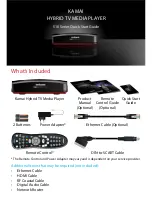
— 16 —
730 ENCODER MENU ITEMS DEFINED
The following tabulation defines and discusses the 81 separate
menus that may be called up for display on the front-panel LCD
screen. Many of these menus may be set or edited with the
front-panel jog wheel. This allows on-site programming with-
out the necessity of connecting a computer, although the sup-
plied Windows® software does much of this automatically and
far more easily.
The jog wheel is rotated to select the menu for editing, pushed
to enter the menu, and then rotated or pushed again to navi-
gate through the menu. Generally a final push accepts the en-
try and displays:
Set!
on the LCD screen. The jog-wheel edit-
ing procedure will be detailed for each of the menu listings that
follow.
Menu No.
Menu Item Description
Jog Wheel Editing Procedure
01
The STATUS menu screen is intended as the ‘de-
fault’ display of the 730 Encoder. This screen:
a) …shows whether the encoder is locked to the
stereo pilot or is running off the encoder’s in-
ternal crystal timebase;
b) …displays the static or dynamic PS messag-
ing that is being sent over the air at that pre-
cise instant;
c) …gives a flashing alarm for the duration of a
TA flag;
d) …shows when Scheduler events are being
transmitted;
e) …shows when the RDS subcarrier has been
turned off.
No jog wheel action is associated with this menu
screen.
02
This screen displays the incoming programming
data from a controlling computer or the station’s
playout system. Programming data is shown in real
time as it is received through any of the encoder’s
data ports. What appears here is exactly what the
encoder is receiving; OK and NO responses are
displayed after each incoming command, showing
that commands are valid or not. The screen auto-
matically clears after two minutes of inactivity. A
complete encoder data refresh will generally scroll
rapidly across the LCD and spill out of the window.
When commands are sent one-at-a-time using the
software Terminal utility (Page 31), the data and its
syntax can be read completely. This screen is use-
ful for troubleshooting the possible corruption of
data sent from the studio to the transmitter site via
an STL serial data link, local area network or Inter-
net, and to verify command syntax.
No jog wheel entry is associated with this menu
screen, but pushing the jog wheel will clear the
screen of data prior to the two-minute timeout.
















































